Ten Native American Superheroes Every Comics Fan Should Know
An odd fact: there were more Native superheroes in comics in the 1940s than the 1960s.
Author’s note: This began as an article about Native superheroes who are now in the public domain, but that left out four important characters that are still protected by copyright, so I’ve expanded this and divided it into two parts.
—Part 1: Six Native American Superheroes in the Public Domain—
- Buckskin (1941)
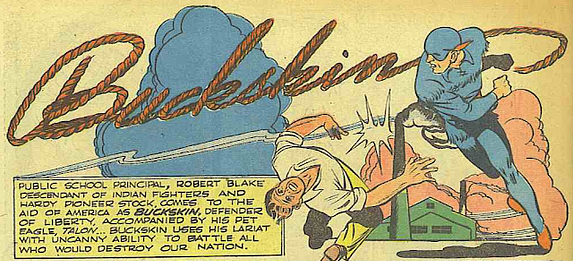
From Buckskin:
Seeking to inspire his students, Robert Blake wears a blue buckskin costume and mask, becoming the hero known as Buckskin (or sometimes Buck Skin Blake). Trained by his grandfather, a former Indian scout, he has no powers but is a skilled fighter and woodsman. He was sometimes aided by his trained eagle, Talon.
One of Buckskin’s stories is reprinted at Four-Color Shadows: Buckskin-Super Mystery Comics-1942. (Ignore its anti-union jingoism)
- The Bronze Terror (1941)
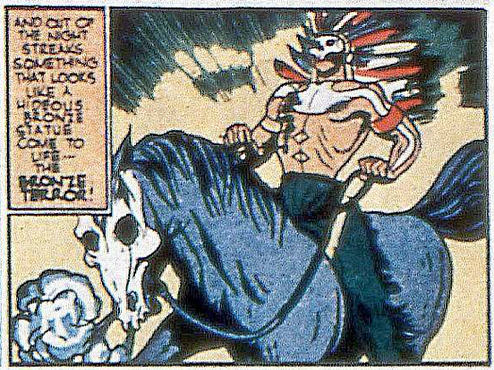
From Bronze Terror:
Returning to his reservation after law school, Apache Jeff Dixon discovers that his father, Chief White Falcon, has been framed for murder. He dons a costume to fight for his father and later for the rest of the Apache Nation against those who would oppress them. He has no powers but is capable in hand-to-hand combat, horseback riding, archery, and is in excellent physical shape from his time as an athlete in school.
The Bronze Terror was probably inspired by the Black Terror — the Bronze Terror was created soon after the Black Terror, and he has the skull imagery that the Black Terror probably got from the Phantom. “Bronze” may be a reference to his race, but the word was also used for black people — the Bronze Buckaroo was a black cowboy. If I wrote the Bronze Terror, I would give him some degree of invulnerability to justify his name.
For more about the character’s creation, his first story, and a discussion of the racial imagery in the context of its time, see The World’s Scariest Lawyer.
- The Bird Man (1940)
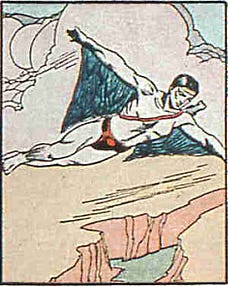
From Bird Man:
The Bird Man, winged hunter of the plains and descendant of an ancient Native American god, was gifted with the ability to fly and the keenness of a bird of prey. His wings were said to be as durable as steel.
The Bird Man may be the least interesting Native superhero: the art and writing on his strip was bad even by the standards of early comic books, and his costume is as minimalistic as the Sub-Mariner’s. The most interesting thing about him is his bow and arrow: a long-range weapon makes sense for a character who flies.
See also: Don Markstein’s Toonopedia: The Bird Man
- Mantoka (1940)
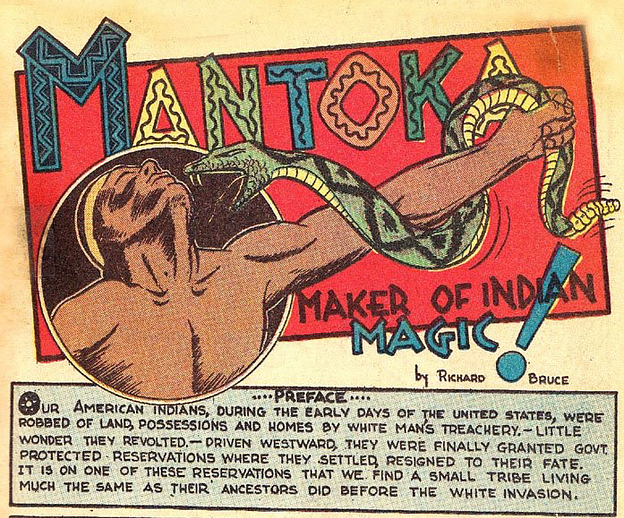
OEric Wilkinson-Gilyard described Mantoka as
A magic, shape-shifting Shaman, who could alter himself (size, density, become animals) and the physical world.
He only made two appearances, but I’m sure that given time, he could have been comparable in power to Stardust, Fantomah, The Sorceress of Zoom. A sort of anything goes character.
See also: Cole’s Comics: Mantoka — Cole’s Indian Shaman Hero (1940)
- Johnny Fox (1940)
Johnny Fox doesn’t have a costume or a secret identity, but his ability to turn invisible makes him a superhero. He was…
…a member of the Seminole tribe of Florida who became a US government investigator and took on missions around the world. His office was in New York. In addition to being an amazing fighter and athlete, Johnny’s grandfather gave him invisibility pills, derived from an ancient Seminole secret, which allowed him to turn invisible for several minutes at a time. He also flew an amphibious craft called “The Flying Gator.”
- Freezum (1941)
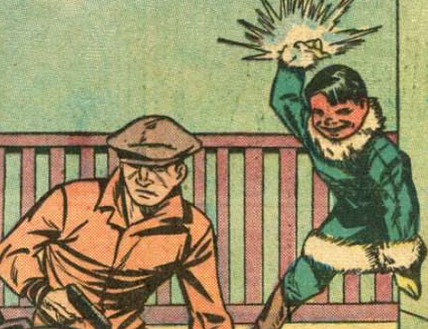
If you look past Freezum’s pidgin speech and clichéd parka outfit, you’ll see that he acts as the equal of his partner and mentor, Sub-Zero—in the first threat that arises, he saves Sub-Zero. As for the parka, Freezum’s partner Sub-Zero also appears to have only one outfit in his closet. Superheroes tend to be sartorially challenged.
I can’t decide if Freezum’s name is stupid or charming. In a revival, he could inherit his mentor’s name or be given a new one.
— Part 1 Bonus! Starlight (1950) —
Because the six public domain Native superheroes are male, I’m adding as a bonus Starlight the Warrior Maiden, an adventurous Native woman whose stories were set in the 19th century. If I was writing a comic with Native superheroes, I would bring her into the present with a time machine or create a descendant with the same name who could become a superhero.
— Part 2: Four More Significant Native American Superheroes—
- Nelvana of the Northern Lights (1941)
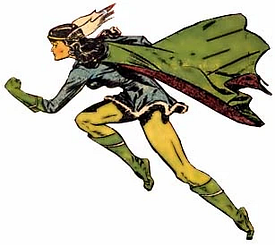
From Nelvana of the Northern Lights:
Nelvana of the Northern Lights is a Canadian comic book character and the first Canadian national superhero, debuting in Hillborough Studios’ Triumph-Adventure Comics #1 (Aug. 1941). She is also one of the first female superheroes, debuting before Wonder Woman but after Fantomah, the Golden Age Black Widow, Invisible Scarlet O’Neil and others introduced in 1940.
- Man-of-Bats (1954)
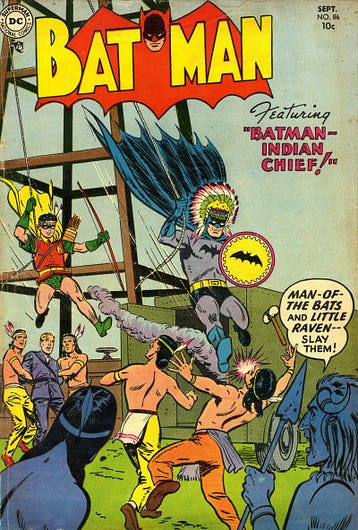
DC’s first Native superhero was a Batman imitator, Man-of-Bats:
Bill Great Eagle is a Native American doctor from South Dakota. After serving in the American army in Iraq, he was inspired to become a costumed defender by Batman, and joined the Club of Heroes. His sidekick was his son, Little Raven, modeling himself after Robin.
Frankly, the less said about the first version of Man-of-Bats, the better. To their credit, DC did give him an original costume when they brought him back decades later:
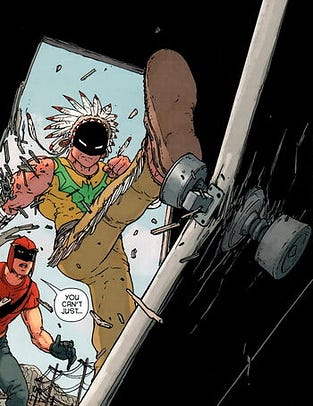
- Red Wolf (1970)
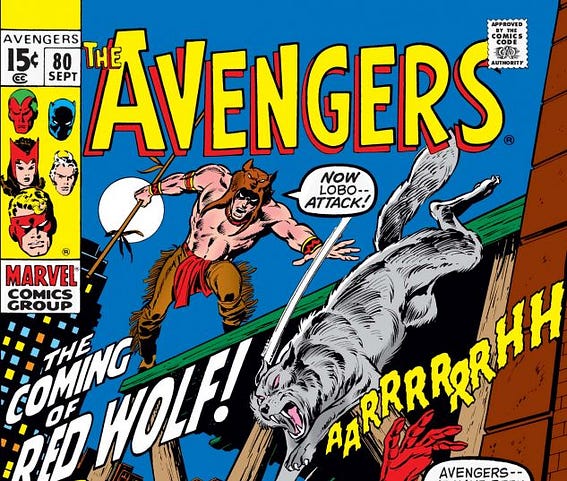
Marvel’s first Native superhero, Red Wolf:
William Talltrees is a man born in modern times, born in Wolf Point, Montana. He was the son of Rebecca and Thomas Talltrees, a Cheyenne tribal leader, and grew up hearing tales of the legendary Red Wolf.[34][35][36] William witnessed his father being intimidated into selling his property to corrupt businessman Cornelius van Lunt and his enfoncer Jason Birch; that night, van Lunt’s henchmen killed William’s family. William swore vengeance, finding and donning the ceremonial garb of Red Wolf. Owayodata visited him and imbued the young man with his spiritual legacy, granting him superhuman powers. The new Red Wolf found a wolf cub that he named Lobo and trained to be his companion.
- Dawnstar (1977)
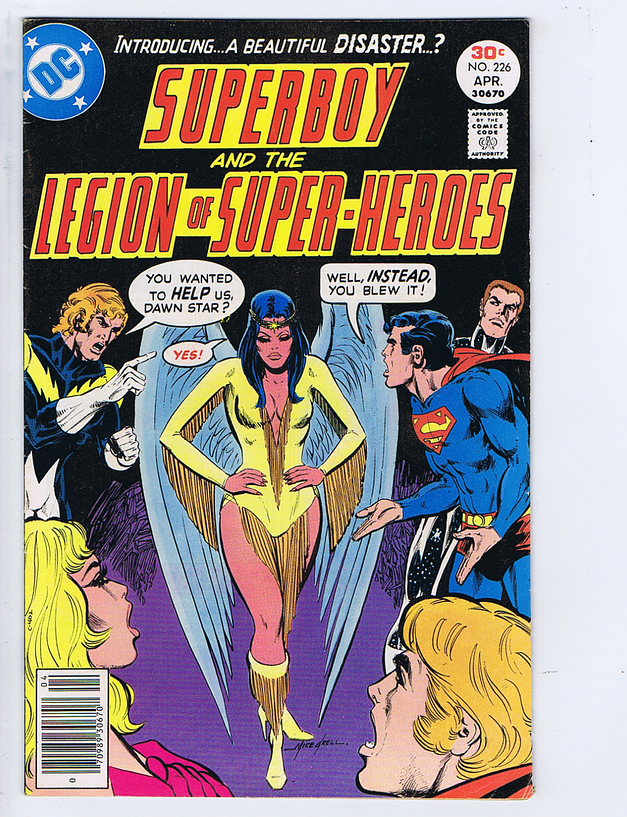
Dawnstar was DC’s first serious attempt at a Native superhero.
Dawnstar (her real name, she has no Legion code name) is from the planet Starhaven, a world colonized by American Indians abducted from Earth by an unknown alien race in the 13th Century. Her name is derived from the appearance on Earth of the planet Venus, the “morning star”, and which is the reason she wears an eight-pointed star ornament on her forehead.
Final note: Searching for examples of Native American superheroes, I focused on 20th century characters. But there are a few set in earlier times who could be called superheroes — see Five Native American Superheroes of the Old West.
Comments
Post a Comment